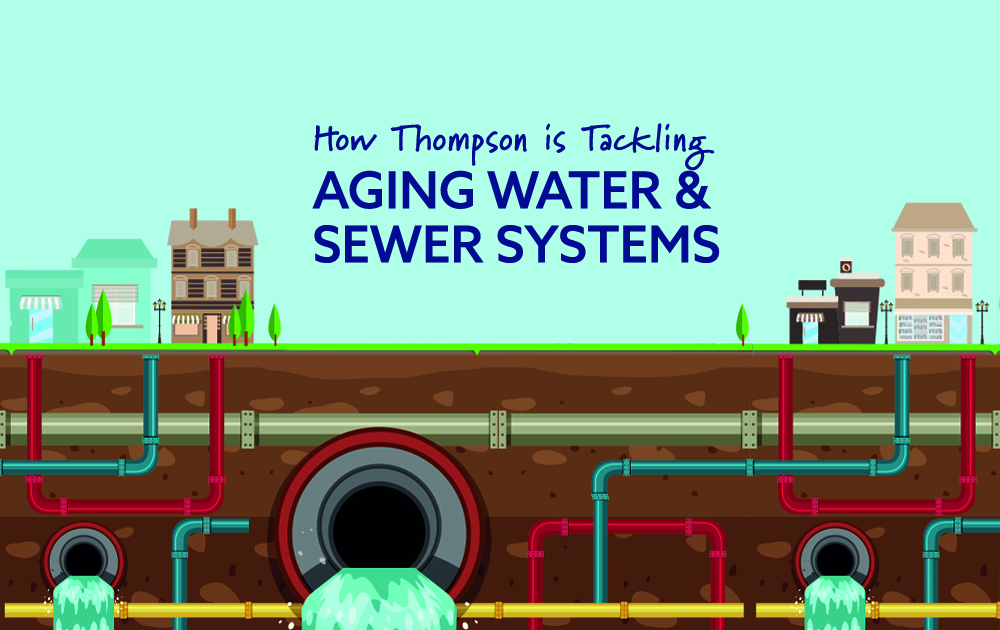It’s not something you see. You don’t think about it. Yet, it’s right here, under our feet, working hard 24/7. It’s the Town of Thompson’s water and sewer infrastructure.
The Town manages 17 water and sewer districts, 5 sewer plants, and 4 water systems. There are many interdependencies between each district. For example, the hamlet of Harris has its own sewer district, yet it pumps its wastewater to the Village of Monticello to be processed.
From bringing you clean drinking water to taking away wastewater, these highly complex systems are essential to our quality of life.
There’s just one problem…they’re aging fast.
So the Town took a proactive approach, and recently commissioned Delaware Engineering to provide a plan that maps out a stable, long-lasting infrastructure. The plan is now complete and the Town wants to share a brief look into the challenges it faces as well as possible solutions for success…
An All-American Issue: Aging Infrastructure
Addressing outdated sewer and water infrastructure isn’t just a Town, County or even regional issue – it’s impacting areas across the U.S.
The EPA estimates that $271 billion is needed to maintain and improve America’s wastewater infrastructure – and $472.6 billion is required to upgrade drinking water systems.
At the heart of the issue is older piping. While today’s pipes are typically made of durable PVC and built to last up to 100 years, older pipes are made of vitrified clay or cement and have a life cycle of about 50 years.
These already-fragile pipes have also been subject to damage from tree root growth and constant clogs from folks disposing of newer products like flushable wipes down their toilets.
Another threat to as well as increased waterflow as the Town’s infrastructure expanded to meet the needs of a growing community.
And there’s another problem: not all systems that the Town manages today, were built by the Town…
The Challenge of “Inheriting” Older Water and Sewer Systems
Many people are surprised to learn that the Town has taken over water and sewer systems that were previously managed by private operators. Perhaps the private entity went bankrupt, yet hundreds of people or businesses depend on that sewer or water system.
That’s when the Town steps in and often discovers things in disarray.
Private owners may have improperly installed pipes or pumps, or neglected their upkeep. Plus, some private entities do not keep accurate or thorough records of sewer and water system construction. One of the most essential elements of this recordkeeping involves creating a detailed map of where pipes are located. If there isn’t a map available, it’s very difficult to know where pipes are located.
For example, the Town took over management of a large private sewer system. The maps provided to the Town were not very detailed. When attempting to repair a sewer pipe, the contractors accidently hit an adjacent water main because there was no indication on the map that a water line was nearby! This resulted in minor flooding and loss of water pressure to customers.
The Town also discovered some issues with the integrity of the original construction of the sewer system. Typically, water and sewer pipelines must be separated by at least 10 feet. When repairing a pipeline, Town workers discovered that in some spots, water and sewer pipes were only separated by 10 inches!
These are just some of the challenges that the Town faces when inheriting private infrastructure. On top of all this, the Town is looking at several federal (EPA) and state (DEC) mandates that require significant work to meet their regulations and requirements – or face high fines and tax levies.
A Closer Look at Rock Hill’s Emerald Green/Lake Louise Marie District
One area the Town has been focused on lately is the Emerald Green/Lake Louise Marie Sewer District. This previously private district is especially challenging due to its size: A wastewater treatment plant, 325 manholes, about 15 miles of sewer mains, and 11 pumping stations scattered across a hilly landscape. The stations process over 410,000 gallons a day of wastewater!
Many of the sewer pumping stations require repair, primarily due to age. Already, the Town has run a camera through the nearby pipes to assess their condition. Pipes that were cracked were replaced or repaired with PVC liner. Joints between pipes were sealed to reduce leakage. The result of this project is a more reliable sewer system and lower overall operating costs.
Built 27 years ago, the wastewater treatment plant equipment and pumping systems are nearing the end of their lifecycles and must be replaced or rehabbed. The Town is currently seeking funding support from grants and other sources to address the Lake Louise Marie Wastewater Treatment Plant, as well as a DEC mandate to integrate a stringent disinfection process.
The Bottom-Line Impact of Upgrading Water and Sewer Systems
In addition to operating smoothly, improved systems can save the Town – and its taxpayers – money. One major issue is ensuring that the Town’s sewer systems are only treating wastewater.
Too often, sewer systems end up taking in rainwater and runoff. This is known as controlling infiltration and inflow, and here’s why it matters.
Let’s say you own a wastewater treatment plant. It costs $1/per gallon to process wastewater at this plant – and you process 500,000 gallons per day. Ok, that’s $500,000 in operating costs. But what if 250,000 of those gallons aren’t wastewater…but rainwater. Yes, you’d be wasting half of your operating costs “treating” rainwater. Plus, you’re wearing down equipment faster than ever.
This is just another reason why the Town is intent on repairing or replacing pipes that have leaks, cracks, loose joints, or other areas where rain water can seep in.
You can also help reduce the amount of rainwater that seeps into our sewer systems by creating a “rain garden” in your own yard!
Looking Down the Line in the Town of Thompson
There’s no avoiding the work that must be done to keep our aging water and sewer systems functioning properly. However, the Town of Thompson is determined to find the most efficient, cost-effective way to achieve a system that works well today – and down the line…


